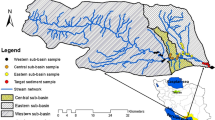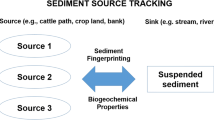Abstract
Identifying sediment provenance in the catchments is essential to the mitigation of sediments' negative effects. This study is the first attempt to quantify the uncertainty associated with contributions supplied by four individual sediment sources (e.g., gully erosion, sheet erosion, rill erosion, and channel bank) by the Generalized Likelihood Uncertainty Estimation (GLUE) with two statistical processes consisting of BRT-KW-DFA (Basic Range Test – Kruskal–Wallis—Discriminant Function Analysis), and RTM-KW-DFA (Range Test based on the Mean—Kruskal–Wallis—Discriminant Function Analysis). Then, the GLUE performance was validated by Virtual Sediment Mixtures (VSMs) samples. A total of 60 samples consisting of 20 samples from the materials deposited in the river bed and 40 source samples were collected from the individual sources consisting of rill erosion (n = 10), sheet erosion (n = 10), gully erosion (n = 10), and channel bank (n = 10). The samples were analyzed for 52 geochemical elements. The performance of GLUE with the final tracers was selected by two statistical combinations consisting of BRT-KW-DFA, and RTM-KW-DFA assessed by the statistical criteria and VSMs. Based on the results, the contributions modeled by GLUE with RTM-KW-DFA statistical process (with a mean value for the MAF (Mean Absolute Fit) = 89; GOF (Goodness Of Fit) = 98; MAE (Mean Absolute Error) = 16, and RMSE (Root Mean Square Error) = 19) are more accurate than the GLUE with BRT-KW-DFA (with a mean value for the MAF = 85; GOF = 97; MAE = 19; and RMSE = 23). Overall, the Sediment Source Fingerprinting (SSF) within the GLUE framework is a useful tool for identifying the sediment source in a wide range of catchments.






Similar content being viewed by others
Data Availability
The datasets used and/or analyzed during the current study are available from the corresponding author upon reasonable request.
References
Behrooz RD, Gholami H, Telfer MW, Jansen JD, Fathabadi A (2019) Using GLUE to pull apart the provenance of atmospheric dust. Aeol Res 37:1–13
Boudreault M, Koiter AJ, Lobb DA, Liu K, Benoy G, Owens PN, Li S (2019) Comparison of sampling designs for sediment source fingerprinting in an agricultural watershed in Atlantic Canada. J Soils Sediments 19(9):3302–3318
Collins A, Walling D, Leeks GJL (1996) Composite fingerprinting of the spatial source of fluvial suspended sediment: a case study of the Exe and Severn River basins. United Kingdom. Géomorphol Relief Process Environ 2(2):41–53
Collins AL, Blackwell M, Boeckx P, Chivers CA, Emelko M, Evrard O, Harris P (2020) Sediment source fingerprinting: benchmarking recent outputs, remaining challenges and emerging themes. J Soils Sediments 20(12):4160–4193
Fatahi A, Gholami H, Esmaeilpour Y, Fathabadi A (2022) Fingerprinting the spatial sources of fine-grained sediment deposited in the bed of the Mehran River, southern Iran. Sci Rep 12(1):1–17
Gellis AC, Hupp CR, Pavich MJ, Landwehr JM, Banks WS, Hubbard BE, Reuter JM (2009) Sources transport, and storage of sediment in the Chesapeake Bay Watershed. US Geol Surv Sci Investig Rep 2008–5186(2009):95
Gholami H, Rahimi S, Fathabadi A, Habibi S, Collins AL (2020) Mapping the spatial sources of atmospheric dust using GLUE and Monte Carlo simulation. Sci Total Environ 723:138090
Goharrokhi M, McCullough GK, Lobb DA, Owens PN, Koiter AJ (2022) Sediment sources and transport dynamics in large, regulated river systems with multiple lakes and reservoirs in the subarctic region of Canada. Hydrol Process e14675
Guo F, Zhang J, Zhu AX, Zhang Z, Zhang H (2021) An assimilation simulation approach for the suspended sediment concentration in inland lakes using a hybrid perturbation generation method. Water Resour Manag 35(6):2007–2022
Koiter AJ, Lobb DA, Owens PN, Petticrew EL, Tiessen KH, Li S (2013) Investigating the role of connectivity and scale in assessing the sources of sediment in an agricultural watershed in the Canadian prairies using sediment source fingerprinting. J Soils Sediments 13(10):1676–1691
Koiter AJ, Owens PN, Petticrew EL, Lobb DA (2018) Assessment of particle size and organic matter correction factors in sediment source fingerprinting investigations: An example of two contrasting watersheds in Canada. Geoderma 325:195–207
Lal R (2003) Soil erosion and the global carbon budget. Environ Int 29(4):437–450
Lal R (2018) Soil quality and food security: the global perspective. In Soil Quality and Soil Erosion (pp. 3–16). CRC Press
Liu B, Niu Q, Qu J, Zu R (2016) Quantifying the provenance of aeolian sediments using multiple composite fingerprints. Aeol Res 22:117–122
Liu Y, Yang W, Yu Z, Lung I, Gharabaghi B (2015) Estimating sediment yield from upland and channel erosion at a watershed scale using SWAT. Water Resour Manag 29(5):1399–1412
Lizaga I, Latorre B, Gaspar L, Navas A (2020) FingerPro: an R package for tracking the provenance of sediment. Water Resour Manag 34(12):3879–3894
Niu B, Tan L, Zhang XJ, Qu J, An Z, Wang J, Li K (2020) Targeted control of sand hazards for a railway in extremely arid regions using fingerprinting approaches. Geomorphology 361:107189
Nosrati K, Akbari-Mahdiabad M, Ayoubi S, Collins AL (2021) An exploratory study on the use of different composite magnetic and colour fingerprints in aeolian sediment provenance fingerprinting. CATENA 200:105182
Owens PN (2022) Sediment source fingerprinting: are we going in the right direction? J Soils Sediments 1–5
Owens PN, Blake WH, Gaspar L, Gateuille D, Koiter AJ, Lobb DA, Woodward JC (2016) Fingerprinting and tracing the sources of soils and sediments: Earth and ocean science, geoarchaeological, forensic, and human health applications. Earth Sci Rev 162:1–23
Park S, Oh C, Jeon S, Jung H, Choi C (2011) Soil erosion risk in Korean watersheds, assessed using the revised universal soil loss equation. J Hydrol 399(3–4):263–273
Pulley S, Collins AL (2018) Tracing catchment fine sediment sources using the new SIFT (SedIment Fingerprinting Tool) open source software. Sci Total Environ 635:838–858
Renard KG, Foster GR, Weesies GA, McCool DK, Yoder DC (1996) Predicting soil erosion by water: A guide to conservation planning with the Revised Universal Soil Loss Equation (RUSLE). Agriculture Handbook 703:23
Slattery M, Walden J, Burt TP (2000) Fingerprinting suspended sediment sources using mineral magnetic measurements-A quantitative approach. Tracers Geomorphol
Thomas J, Joseph S, Thrivikramji KP (2018) Assessment of soil erosion in a tropical mountain river basin of the southern Western Ghats, India using RUSLE and GIS. Geosci Front 9(3):893–906
Vale SS, Fuller IC, Procter JN, Basher LR, Smith IE (2016) Characterization and quantification of suspended sediment sources to the Manawatu River, New Zealand. Sci Total Environ 543:171–186
Walling DE (2013) The evolution of sediment source fingerprinting investigations in fluvial systems. J Soils Sediments 13(10):1658–1675
Walling DE (2005) Tracing suspended sediment sources in catchments and river systems. Sci Total Environ 344(1–3):159–184
Wischmeier WH, Smith DD (1978) Predicting rainfall erosion losses: a guide to conservation planning (No. 537). Dept Agric Sci Educ Admin
Zhao Y, Gao G, Ding G, Zhou Q, Zhang Y, Wang J, Zhou J (2022) Improving the performance of an unmixing model in sediment source apportionment using synthetic sediment mixtures and an adaptive boosting algorithm. CATENA 217:106491
Zhao Y, Gao GL, Zhang Y, Ding GD, Zhou JX, Chen YX, Zhou QZ (2020) Aeolian sediment fingerprinting in the Cuona Lake section along the Qinghai-Tibetan railway. J Clean Prod 261:121233
Zhao Y, Zhou Q, Gao G, Ding G, Zhang Y, Zhou J (2021) A new methodological framework coupling computational fluid dynamics and fingerprinting for assessment of aeolian sediment transport processes. CATENA 204:105372
Acknowledgements
This research has been funded by Soil Conservation and Watershed Management Research Institute, Education and Extension Organization (AREEO), Tehran, Iran (grant number 2-50-29-008-990229). The authors would like to thank the Soil Conservation and Watershed Management Research Institute, Fars Agricultural and Natural Resources Research and Education Center, and Cnetral lab of the University of Hormozgan, Iran for supporting this joint research project.
Author information
Authors and Affiliations
Contributions
S.M.S: Software & Formal analysis. H.G: Formal analysis, Investigation, Visualization, Writing original draft, Supervision, Project administration, Review & editing. O.R: Investigation & Writing original draft. S.S: Software & Formal analysis.
Corresponding author
Ethics declarations
Ethics Approval
Not applicable.
Consent to Participate
Not applicable.
Consent for Publication
Not applicable.
Competing Interests
The authors declare no competing interests.
Additional information
Publisher's Note
Springer Nature remains neutral with regard to jurisdictional claims in published maps and institutional affiliations.
Rights and permissions
Springer Nature or its licensor (e.g. a society or other partner) holds exclusive rights to this article under a publishing agreement with the author(s) or other rightsholder(s); author self-archiving of the accepted manuscript version of this article is solely governed by the terms of such publishing agreement and applicable law.
About this article
Cite this article
Soleimanpour, S.M., Gholami, H., Rahmati, O. et al. Fingerprinting Sources of Fine-grained Sediment Deposited in a Riverine System by GLUE. Water Resour Manage 37, 899–913 (2023). https://doi.org/10.1007/s11269-022-03412-w
Received:
Accepted:
Published:
Issue Date:
DOI: https://doi.org/10.1007/s11269-022-03412-w




